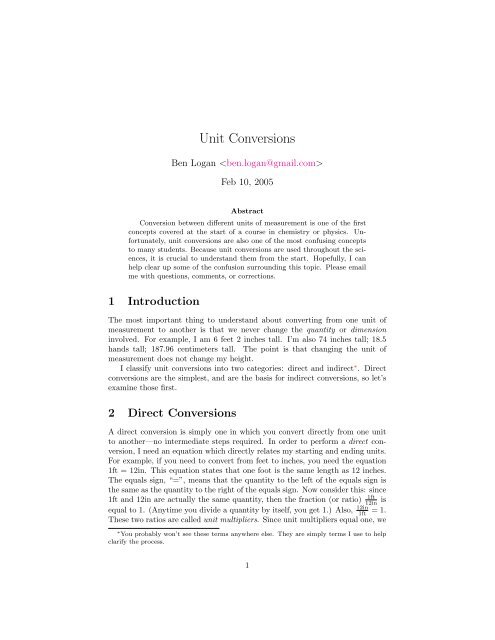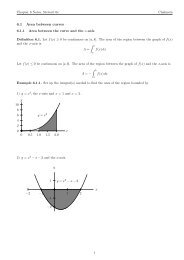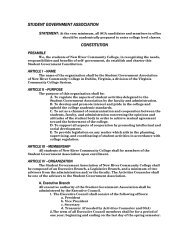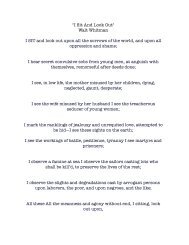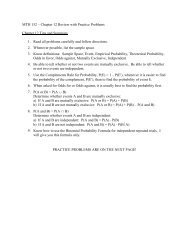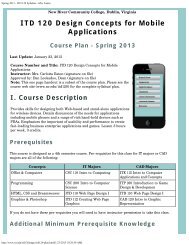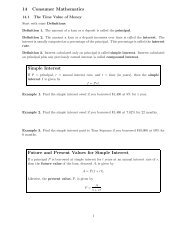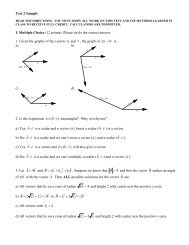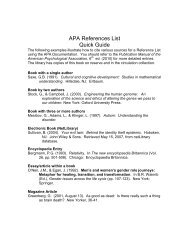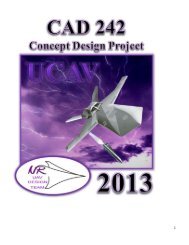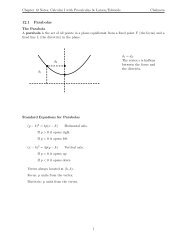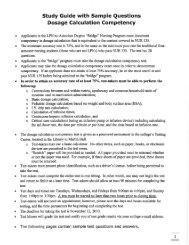Unit Conversions
Unit Conversions
Unit Conversions
You also want an ePaper? Increase the reach of your titles
YUMPU automatically turns print PDFs into web optimized ePapers that Google loves.
we use the fact that 1ft=12in, and our two unit multipliers areOnce again, choose the multiplier that cancels the feet:6ft1 × 12in1ft = 6 × 121ft · inft= 72in1ft12inand12in1ft .To get from inches to centimeters, we use the fact that 1in=2.54cm, and choose1in 2.54cmfrom the two unit multipliers2.54cmand1in :72in1× 2.54cm1in=72 × 2.54 in · cm= 182.88cm1 inAlternatively, we could combine the steps and do it all at once:6ft1 × 12 in1ft × 2.54cm = (6 × 12 × 2.54)cm = 182.88cm1in4 Squared and Cubed <strong>Unit</strong>sWhen dealing with units which are squared or cubed (e.g., in 2 or cm 3 ), youmust be careful to use your unit multipliers the correct number of times.For example, if I need to convert 100cm 3 to in 3 , and am given that 1in=2.54cm,then I can do one of two things:1. Cube both sides of the equation 1in=2.54cm, which gives me 1in 3 =16.39cm 3 . Now I can use my new unit multiplier one time:100✟cm ✟32. Use the unit multiplier1in2.54cm100cm 311× 1in2.54cm ×× 1in316.39✟cm ✟ = 1003 16.39 in3 = 6.10in 31in2.54cm ×three times:100✟cm ✟311in2.54cm =× 13in 32.54 3 ✟cm ✟ = 1003 16.39 in3 = 6.10in 3Likewise, for squared units, you would either square both sides of your conversionequation, or use the unit multiplier twice.The above explanation makes sense if you think about it this way: assumethat you have a packing box, and you need to find the volume in cubicinches, but the dimensions are printed on the box in centimeters. The volumeis length × width × height, so you would have to convert all three dimensionsfrom centimeters to inches before multiplying. That is, you would have to usethe unit multiplier that relates inches and centimeters three times.3
5 Compound <strong>Unit</strong>sA compound unit is one made up of other units. For example, feet per second(ft/s) and pounds per cubic foot (lb/ft 3 ) are compound units. The process ofconverting from one compound unit to another simply requires you to use moreunit multipliers.To convert 88 ft/s to mi/hr (miles per hour), I need to convert feet to milesand convert seconds to hours. I will go directly from feet to miles using the1mi5280ftequation 1mi=5280ft and the corresponding unit multiplier . Then I willgo from s→min→hr using the facts that 1hr=60min and 1min=60s. Here it isall in one long step—pay close attention to what cancels:88ft1s × 1mi✄ 5280ft × 60s✄1✟min ✟ × 60 ✟min✟1hr=88 × 60 × 60 mi5280 hr = 60mi hrNotice how units don’t have to be adjacent to cancel. Everything in thenumerators gets multiplied together and everything in the denomenators getsmultiplied together—the order doesn’t matter.4
6 Example ProblemsHere are some more examples. Remember, practice makes perfect—try to workthese yourself before looking at the solutions. I have provided all the conversionsyou need in Section 8.1. Convert 12 inches to centimeters.Solution2. Convert 3 yards to inches.Solution3. How many miles is a 10km race?Solution4. How many cubic inches are in a gallon?Solution5. Convert 50 ft/s to m/s.Solution6. How many mL are in a pint (pt)?Solution5
7 Solutions to Example Problems1. Look in the table and find the conversion that relates inches and centimeters:1in=2.54cm. The two possible unit multipliers are1in2.54cm and 2.54cm1inWe are trying to get rid of the inches, so we need to use the secondmultiplier:12in1× 2.54cm1in= 12 × 2.54cm = 30.48cm2. Looking in the table, you’ll see that there is no equation directly relatingyards and inches. However, there is one relating yards and feet, and onerelating feet and inches. So our path will be yd→ft→in.3 yd1 × 3 ft1 yd × 12in = (3 × 3 × 12)in = 108in1ft3. Because there is no equation in our table which directly relates kilometersand miles, we need to find a chain of conversions which will get us there.We need to follow the path km→m→cm→in→ft→mi.10✟ ✟ km1× 1000✚m1✟km✟× 100 ✟✟ cm1✚m × 1 in2.54✟✟ cm × 1 ft12in ×1mi5280ft =10 × 1000 × 100mi ≈ 6.21mi2.54 × 12 × 52804. Be very careful here because the gallon is a unit of volume. Again, welook in the table and find that we can convert from gallons to liters. Fromliters we can convert to milliliters; from milliliters to cubic centimeters;and from cubic centimeters to cubic inches. Let’s shorten the conversionprocess by first cubing the relation between inches and centimeters:(1in) 3 = (2.54cm) 3 −→ 1in 3 = 16.39cm 3Now we can proceed with the conversion—watch the cancellations:1 ✚ gal1 × 3.785 ✓L1 ✚ gal× 1000✟✟ mL× 1✟✟ cm 31✓L 1✟mL ✟ ×1in316.39✟cm ✟3.785 × 1000= in 3 ≈ 231in 33 16.396
5. Don’t let the fact that these are compound units throw you off. All weare really converting is ft to m, and looking at the table we see that weneed to go from feet to inches to centimeters to meters:50ft1s × 12 in1ft × 2.54 ✟✟ cm1in× 1m100✟✟ cm50 × 12 × 2.54 m=100 s = 15.24m s6. Looking at the conversion table, we see that we need to convert from pintsto quarts to gallons to liters to milliliters.1pt1 × 1 qt2pt × 1 ✚ gal4qt × 3.785 ✓L1 ✚ gal× 1000mL1✓L=3.785 × 1000mL ≈ 473.1mL2 × 47
8 Table of <strong>Conversions</strong>The following table is included for the purpose of illustration—it is far frombeing a comprehensive table of conversions, but contains all of the conversionsnecessary to work the problems in this document. Your science book shouldcontain a more comprehensive table.3 Length1 ft=12 in 1 in=2.54 cm 1 m=100 cm 1 mi=5280 ft1 cm=10 mm 1 km=1000 m 1 yd=3 ftVolume1 gal=4 qt 1 gal=3.785 L 1 qt=2 pt 1 L=1000 mL1 mL=1 cmMiscellaneous1 kg=2.205 lb † 1 N=.225 lb 180 ◦ =π rad 1 hp=745.7 W† If you are taking physics you should know that this is technically not correct! The kilogram(kg) is a unit of mass, but the pound (lb) is a unit of force. 1 kg only equals 2.205 lb if theacceleration due to gravity is 9.8 m/s 2 .8


